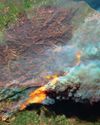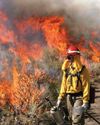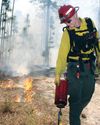THE MAGMA HAMMER STRIKES
Muse Science Magazine for Kids
|October 2023
Tonga's Recent Massive Underwater Eruption

There are more than 1,300 active volcanoes on the planet. Some erupt continuously for many years, while others erupt suddenly with little to no warning. On Jan. 15, 2022, the world was largely caught off guard with the world's most violent volcanic eruption ever recorded with modern instruments. It occurred in Hunga Tonga-Hunga Ha'apai (HUNG-ah TONG-ah-HUNG-ah ha-AHpie), Tonga, in the South Pacific.
But HT-HH, as it's now sometimes called, hadn't really come out of nowhere. This submarine volcano had erupted out of the ocean back in January 2015, creating a new island. The volcano was located 65 kilometers (40 miles) north of Tonga's capital, Nuku'alofa, and joined together two small uninhabited islands called Hunga Tonga and Hunga Ha'apai. That's where the volcano's full name came from. After the 2022 eruption, small pieces of those two islands are the only parts of the volcano that remain above the water.
Though these islands reach only 374 feet (114 meters) above the sea, Hunga Tonga-Hunga Ha'apai is huge. Rising from the seafloor, it measures 1.1 mile (1.8 km) high and 12.4 miles (20 km) wide. The underwater mountain is part of a sweeping arc of volcanoes that form the Tongan part of the Pacific "Ring of Fire."

Volcanic Awakening
Between 2015 and 2021, the volcano erupted occasionally. But these events were considered relatively mild. "They were the kind of eruptions that you could be within a few miles of and still be considered safe," says Kevin Mackay. He is a marine geologist at the National Institute of Water and Atmospheric Research (NIWA) in New Zealand. "There was nothing that would lead us to think a major eruption could even happen," Mackay adds.
Esta historia es de la edición October 2023 de Muse Science Magazine for Kids.
Suscríbete a Magzter GOLD para acceder a miles de historias premium seleccionadas y a más de 9000 revistas y periódicos.
¿Ya eres suscriptor? Iniciar sesión
MÁS HISTORIAS DE Muse Science Magazine for Kids

Muse Science Magazine for Kids
ANIMAL FIREFIGHTER TO THE RESCUE
Can animals help manage the risks of deadly wildfires?
3 mins
Muse July 2025: The Story Behind Wildfires

Muse Science Magazine for Kids
FIRE DANGER
WHY THE RISK OF WILDFIRES KEEPS GROWING
4 mins
Muse July 2025: The Story Behind Wildfires

Muse Science Magazine for Kids
The Miller NEW Normal
WHAT TODAY’S WILDFIRES TELL US ABOUT OUR FUTURE
8 mins
Muse July 2025: The Story Behind Wildfires

Muse Science Magazine for Kids
WOMEN AND FIREFIGHTING: A GOOD FIT
Jessica Gardetto is a firefighter. Her father was, too. “I grew up with my dad coming home smelling like wildfire and covered in soot,” she says.
1 min
Muse July 2025: The Story Behind Wildfires

Muse Science Magazine for Kids
What is happening on your fingertips when they get all wrinkly in a hot tub?
—Felix G., age 10, Montana
1 mins
Muse July 2025: The Story Behind Wildfires

Muse Science Magazine for Kids
WHEN the SMOKE CLEARS
THE LINGERING EFFECTS OF THE RECENT PACIFIC PALISADES AND ALTADENA EATON FIRES
6 mins
Muse July 2025: The Story Behind Wildfires

Muse Science Magazine for Kids
PICKING TEAMS
Keep it fair with a strategy that relies on geometry.
2 mins
Muse July 2025: The Story Behind Wildfires

Muse Science Magazine for Kids
SHAN CAMMACK
WILDLIFE BIOLOGIST AND FIRE SAFETY OFFICER
3 mins
Muse July 2025: The Story Behind Wildfires

Muse Science Magazine for Kids
Scientists Create Mice With Woolly Mammoth-Like Fur
RESEARCHERS AT A COMPANY IN TEXAS ARE WORKING TO CREATE A LIVING ANIMAL THAT RESEMBLES THE EXTINCT WOOLLY MAMMOTH. Recently, they produced mice with traits of the large mammal. The mice all have coats with mammoth-like fur, and some of the small mammals also have genes that help them store fat. Both features would help the animals survive in the cold Arctic, where the woolly mammoth once lived.
1 min
Muse July 2025: The Story Behind Wildfires

Muse Science Magazine for Kids
Cool Sunshade Added to the Nancy Roman Space Telescope
THE NANCY ROMAN SPACE TELESCOPE IS A NEW TELESCOPE THAT NASA IS BUILDING AND WILL LAUNCH INTO SPACE, LIKELY IN EARLY 2027.
1 min
Muse July 2025: The Story Behind Wildfires
Translate
Change font size

